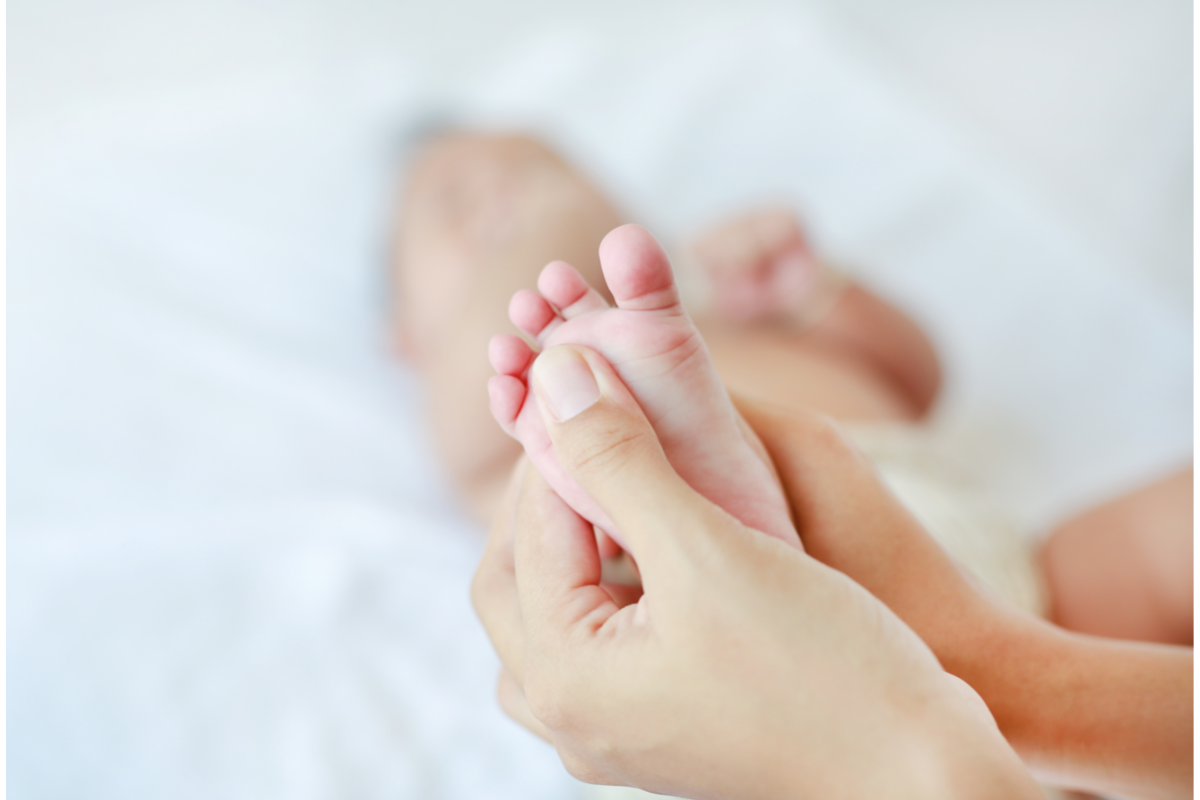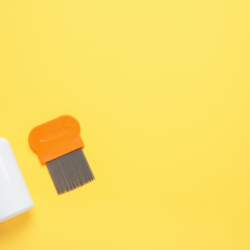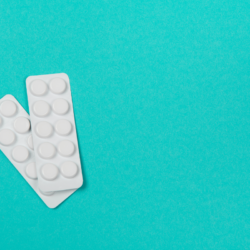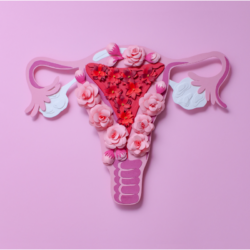Massage is in fact a very relaxing and special tactile exchange that has many benefits. Both for ourselves and for babies. As far as babies are concerned, massage helps them to gain weight, reduces stress, stimulates blood circulation and contributes to the quality of their sleep…
What’s more, massage is an additional opportunity for your little one to strengthen their bond with mum or dad. And why is that? Quite simply because physical contact accelerates the secretion of the hormone linked to attachment:Oxytocin. Finally, massaging baby is an opportunity to convey all your tenderness and love through this moment of physical intimacy.
History of baby massage
Origins and evolution
Massage for babies is an age-old tradition that has its origins in cultures around the world. Passed down from generation to generation, the practice has played an important role in infant care rituals and in strengthening family ties.
Ancient roots in many cultures
Infant massage has deep roots in many civilisations, particularly in India, Africa and Asian cultures. In India, for example, massage is an integral part of Ayurveda, a traditional system of medicine. It is commonly practised to stimulate circulation, promote relaxation and help babies sleep.
In African cultures, massage is often performed by mothers as a means of communicating with their child, relieving certain common ailments and strengthening muscles. In China and other Asian countries, infant massage is used to improve overall health and prevent illness.
The rise of baby massage in the West
It was only in the second half of the 20th century that infant massage gained popularity in the West. Inspired by traditional practices in other cultures, many therapists and health professionals began to recognise the benefits of massage for the physical and emotional development of infants.
Studies carried out in the 1970s and 1980s highlighted the positive effects of massage, particularly in terms of growth, psychomotor development and strengthening the parent-child bond. This research contributed to the integration of infant massage into routine care.
Evolution of techniques and training
As interest in children’s well-being and development has grown, infant massage techniques have evolved. Today, these techniques are more structured and adapted to the specific needs of infants. The training of massage professionals has also developed, with certification and specialised programmes.
Parents are now encouraged to practise baby massage not only for the physical benefits, but also for the emotional bond it creates. It has become a special moment of tenderness and non-verbal communication between parent and child.
Preparing to massage a baby
Massaging your little angel can’t be improvised. It requires preparation, which is a stage that should not be neglected.
Precautions to bear in mind
A newborn baby is a very fragile little creature. It’s normal for parents to be protective and apprehensive. That’s why we need to be well prepared in every respect. It’s important to know that if your baby has health problems or is premature, you should seek the advice of a paediatrician before taking any action.Hygiene is also essential. We need to disinfect our hands and cut our fingernails to avoid injuring baby.
Since a massage is above all relaxing, we need to create a calm environment with a comfortable room temperature for baby’s well-being.
Choosing the right oil
Natural is always the best choice! Because baby’s skin is so delicate, it’s best to use organic vegetable oils like PRANABB Sweet Almond Baby Massage Oil, specially designed for sensitive skin. This massage oil is based on sweet almond and vanilla. It helps to regenerate the skin ‘ s hydrolipidic film, which strengthens baby’s skin barrier.
Weleda Belly Massage Oil for Babies is ideal for massaging your baby’s tummy to promote well-being during digestion. There’s no need to worry, as this oil contains no preservatives, colourings or synthetic fragrances.
Massage techniques for your baby’s well-being
- Tummy: for this procedure, place your baby on his back with his legs bent. Then place your hand on his tummy and make small circular movements, applying gentle pressure.
- Face: always keep your baby lying on his back. Gently massage his face with both hands, moving down to his neck. Gently and delicately, point your fingers towards his ears and gently pinch his sinuses.
- Hands and feet: Place your baby on his stomach. Then take turns massaging his hands and feet. Be careful not to lift his limbs too much. At the end, rest his hand or foot in your hand, then gently knead his palm or the arch of his foot, and massage his fingers and toes.
- Back: Place the baby on your lap, with his tummy against you. Then slide your hand from top to bottom to massage his back, from the nape of his neck to his buttocks; finally, make small circles on his lower back.
How do you massage your baby?
It’s important to choose the right moment to massage your baby. Choose a time when your baby is calm and relaxed, for example after bath time or before bedtime. Avoid massaging your baby just after a meal, as this can cause digestive discomfort.
Create the right atmosphere
Create a peaceful, comfortable atmosphere for the massage. Choose a quiet, warm place with subdued lighting. You can play soft music in the background to encourage relaxation.
Basic movements
There are several basic movements you can use to massage your baby. Here are some of the most common:
- Effleurage strokes
Effleurage involves gently gliding your hands over your baby’s skin, following the contours of his or her body. These movements should be light and fluid, without exerting too much pressure.
- Kneading movements
Kneading involves gently grasping your baby’s muscles between your fingers and giving them a gentle squeeze. These movements help to relax the muscles and improve blood circulation.
- Pressing movements
Pressing involves gently pressing on certain parts of your baby’s body, such as the shoulders, thighs or feet. These movements should be carried out with care, taking into account your baby’s fragility.
Why massage your baby?
In this part of the article, we’ll explore the reasons why massage is beneficial for your baby. We’ll look at the benefits of massage for your baby’s physical and emotional health, as well as for strengthening the parent-child bond. You’ll discover how massage can improve digestion, stimulate development, and promote soothing and relaxation in your baby.
Strengthening emotional bonds
Infant massage is an excellent way to create and strengthen the bond between you and your baby. By massaging your baby, you establish physical contact, which encourages attachment and mutual love.
Improving digestion
Massage can help improve your baby’s digestion by stimulating the internal organs and encouraging the production of digestive juices. It can also help relieve colic and gas.
Soothing and relaxing
Massage is an effective way of soothing and relaxing your baby. It can help reduce crying and improve the quality of your baby’s sleep.
The impact of massage on babies’ cognitive development
The impact of massage on the long-term development of infants, particularly growth and cognitive development, has been the subject of various studies. The results suggest significant benefits, but with certain nuances to be taken into account.
One study examined the short- and long-term effects of massage on premature infants, revealing that babies who had received massage had better cognitive scores at the age of 12 months. Although the study found no significant differences in weight gain, length of hospital stay or motor development between the massaged and control infants, it concluded that massage could be a beneficial intervention for premature infants in the neonatal intensive care unit (NICU) to improve weight gain and promote mental development.
Another systematic review on the effects of infant massage found that in several studies, massage helped to relieve pain, improve bilirubin (jaundice) levels and increase weight gain in infants. However, the review also pointed out that, although the results were positive, they should be interpreted with caution due to the variability in the quality of the studies included. No negative side effects of massage were observed, suggesting that massage could be beneficial in these areas. Nevertheless, further research is needed for a more in-depth understanding of these effects in the context of child healthcare.
Finally, a meta-analysis also evaluated the effectiveness of massage on short- and long-term outcomes in premature infants. It found a significant improvement in mental scores and higher average daily weight gain in infants who received massage. However, the study emphasised that, due to the great heterogeneity and sometimes low quality of certain studies, it was not possible to draw any definitive recommendations. The study concluded by stressing the need for more randomised controlled trials to add to existing knowledge on this subject.
References
- https://www.ncbi.nlm.nih.gov/pmc/articles/PMC9179989/
- https://www.ncbi.nlm.nih.gov/pmc/articles/PMC9309640/
- https://www.ncbi.nlm.nih.gov/pmc/articles/PMC9577283/
- Infant Behav Dev. 2013 Dec;36(4):662-9. doi: 10.1016/j.infbeh.2013.06.009. Epub 2013 Aug 7.
The efficacy of massage on short and long term outcomes in preterm infants - Int J Environ Res Public Health. 2022 May 24;19(11):6378. doi: 10.3390/ijerph19116378.
Effects of Infant Massage: A Systematic Review - MCN Am J Matern Child Nurs. 2015 Nov-Dec;40(6):344-58. doi: 10.1097/NMC.0000000000000177.
A Meta-Analysis of Preterm Infant Massage: An Ancient Practice With Contemporary Applications





